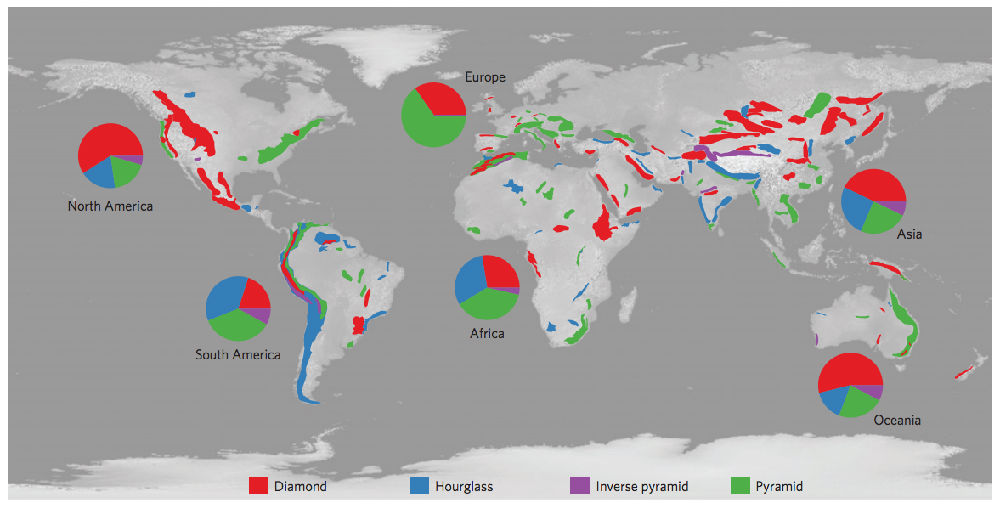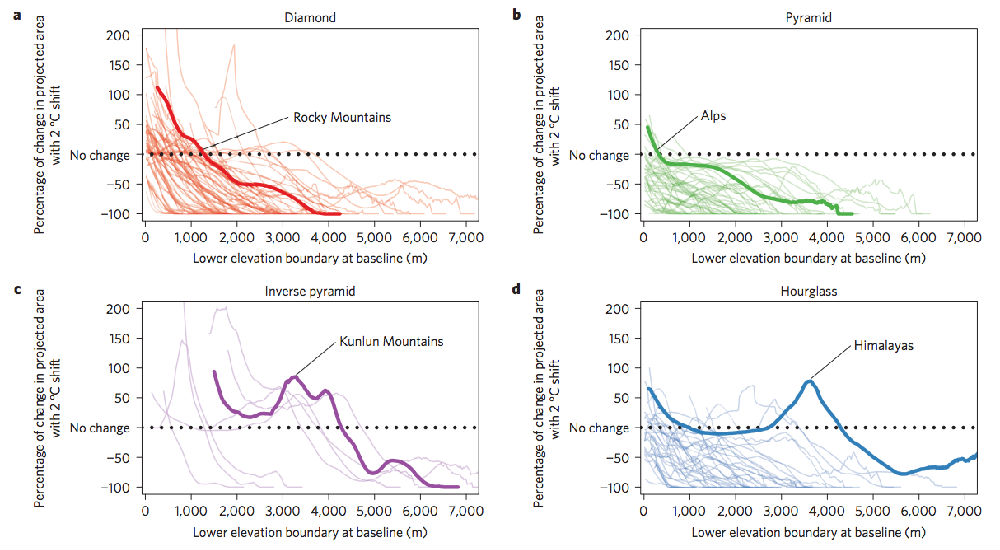博文
四座大山
||
一个有趣的问题是,气候变化背景下山地生物多样性会怎么变化?山地往往是物种形成和分化的中心,对生物多样性和种质资源保护具有重要的意义,但人们对山地面积随着海拔的上升会发生怎么样的变化还不是很了解。如,随着海拔的上升,山地面积都是减少的吗?最近的一项研究表明,答案是否定的。
普林斯顿大学的Elsen和Tingley在对全球182座山的地形地貌进行量化时发现,68%的山地面积没有随着海拔的升高而单调降低。有意思的是,作者把世界上的大山根据地形地貌特征分成四种类型,如落基山脉(Rocky Mountains) (菱形),阿尔卑斯山(the Alps) (金字塔形),昆仑山脉(the Kunlun Mountains) (倒金字塔形) 以及喜马拉雅山(the Himalayas) (沙漏形)。其中,仅32%的山地的面积是随着海拔的升高是减少的,6%甚至是逐渐增加的,其余的在山间或中间海拔面积是增加的(倒金字塔形和沙漏形:The most common mountain shape in the new study is the diamond (39%), followed by the traditional pyramid (32%), the hourglass (23%) and the inverse pyramid (6%))。这个研究表明,如果物种因响应气候变暖而迁向高海拔山地的时候,情况可能不是很糟糕,毕竟,还是有地方住的。
作者总结出了四种类型的山脉,这点很有意思。这四种类型的山就像压在地球头上的“四座大山”。那么,研究这个地形地貌有什么价值呢?它指引我们,当进行物种保护的时候要注意山地的地形,小心可能限制物种迁移的瓶颈,如菱形、倒金字塔和沙漏形在中间海拔均有明显的限制区或瓶颈。
相关研究论文“Global mountain topography and the fate of montane species under climate change”已经发表在知名期刊Nature Climate Change上。
摘要:
Increasing evidence indicates that species throughout the world are responding to climate change by shifting their geographic distributions. Although shifts can be directionally heterogeneous, they often follow warming temperatures polewards and upslope. Montane species are of particular concern in this regard, as they are expected to face reduced available area of occupancy and increased risk of extinction with upslope movements. However, this expectation hinges on the assumption that surface area decreases monotonically as species move up mountainsides. We analysed the elevational availability of surface area for a global data set containing 182 of the world’s mountain ranges. Sixty-eight per cent of these mountain ranges had topographies in which area did not decrease monotonically with elevation. Rather, mountain range topographies exhibited four distinct area–elevation patterns: decreasing (32% of ranges), increasing (6%), a mid-elevation peak inarea (39%), and a mid-elevation trough in area (23%). These findings suggest that many species, particularly those of foothills and lower montane zones, may encounter increases in available area as a result of shifting upslope. A deeper understanding of underlying mountain topography can inform conservation priorities by revealing where shifting species stand to undergo area increases, decreases and bottlenecks as they respond to climate change.



https://blog.sciencenet.cn/blog-260340-1074594.html
上一篇:全球植被光合对干旱的恢复力评估
下一篇:新闻报道影响居民用水